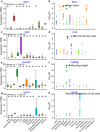Integration of a single-step genome-wide association study with a multi-tissue transcriptome analysis provides novel insights into the genetic basis of wool and weight traits in sheep
- PMID: 34193030
- PMCID: PMC8247193
- DOI: 10.1186/s12711-021-00649-8
Integration of a single-step genome-wide association study with a multi-tissue transcriptome analysis provides novel insights into the genetic basis of wool and weight traits in sheep
Abstract
Background: Genetic improvement of wool and growth traits is a major goal in the sheep industry, but their underlying genetic architecture remains elusive. To improve our understanding of these mechanisms, we conducted a weighted single-step genome-wide association study (WssGWAS) and then integrated the results with large-scale transcriptome data for five wool traits and one growth trait in Merino sheep: mean fibre diameter (MFD), coefficient of variation of the fibre diameter (CVFD), crimp number (CN), mean staple length (MSL), greasy fleece weight (GFW), and live weight (LW).
Results: Our dataset comprised 7135 individuals with phenotype data, among which 1217 had high-density (HD) genotype data (n = 372,534). The genotypes of 707 of these animals were imputed from the Illumina Ovine single nucleotide polymorphism (SNP) 54 BeadChip to the HD Array. The heritability of these traits ranged from 0.05 (CVFD) to 0.36 (MFD), and between-trait genetic correlations ranged from - 0.44 (CN vs. LW) to 0.77 (GFW vs. LW). By integrating the GWAS signals with RNA-seq data from 500 samples (representing 87 tissue types from 16 animals), we detected tissues that were relevant to each of the six traits, e.g. liver, muscle and the gastrointestinal (GI) tract were the most relevant tissues for LW, and leukocytes and macrophages were the most relevant cells for CN. For the six traits, 54 quantitative trait loci (QTL) were identified covering 81 candidate genes on 21 ovine autosomes. Multiple candidate genes showed strong tissue-specific expression, e.g. BNC1 (associated with MFD) and CHRNB1 (LW) were specifically expressed in skin and muscle, respectively. By conducting phenome-wide association studies (PheWAS) in humans, we found that orthologues of several of these candidate genes were significantly (FDR < 0.05) associated with similar traits in humans, e.g. BNC1 was significantly associated with MFD in sheep and with hair colour in humans, and CHRNB1 was significantly associated with LW in sheep and with body mass index in humans.
Conclusions: Our findings provide novel insights into the biological and genetic mechanisms underlying wool and growth traits, and thus will contribute to the genetic improvement and gene mapping of complex traits in sheep.
Conflict of interest statement
The authors declare that they have no competing interests.
Figures





Similar articles
-
Multiple-trait QTL mapping and genomic prediction for wool traits in sheep.Genet Sel Evol. 2017 Aug 15;49(1):62. doi: 10.1186/s12711-017-0337-y. Genet Sel Evol. 2017. PMID: 28810834 Free PMC article.
-
Comprehensive transcriptome and methylome analysis delineates the biological basis of hair follicle development and wool-related traits in Merino sheep.BMC Biol. 2021 Sep 9;19(1):197. doi: 10.1186/s12915-021-01127-9. BMC Biol. 2021. PMID: 34503498 Free PMC article.
-
A conditional multi-trait sequence GWAS discovers pleiotropic candidate genes and variants for sheep wool, skin wrinkle and breech cover traits.Genet Sel Evol. 2021 Jul 8;53(1):58. doi: 10.1186/s12711-021-00651-0. Genet Sel Evol. 2021. PMID: 34238208 Free PMC article.
-
Advances in genome-wide association studies for important traits in sheep and goats.Yi Chuan. 2017 Jun 20;39(6):491-500. doi: 10.16288/j.yczz.17-021. Yi Chuan. 2017. PMID: 28903908 Review.
-
Review on Genomic Regions and Candidate Genes Associated with Economically Important Production and Reproduction Traits in Sheep (Ovies aries).Animals (Basel). 2019 Dec 23;10(1):33. doi: 10.3390/ani10010033. Animals (Basel). 2019. PMID: 31877963 Free PMC article. Review.
Cited by
-
Genomic Regions Associated with Wool, Growth and Reproduction Traits in Uruguayan Merino Sheep.Genes (Basel). 2023 Jan 7;14(1):167. doi: 10.3390/genes14010167. Genes (Basel). 2023. PMID: 36672908 Free PMC article.
-
Weighted single-step genome-wide association study for direct and maternal genetic effects associated with birth and weaning weights in sheep.Sci Rep. 2024 Jun 7;14(1):13120. doi: 10.1038/s41598-024-63974-0. Sci Rep. 2024. PMID: 38849438 Free PMC article.
-
Exploring the polygenic landscape of wool traits in Turkish Merinos through multi-locus GWAS approaches: middle Anatolian Merino.Sci Rep. 2025 Mar 27;15(1):10611. doi: 10.1038/s41598-025-95099-3. Sci Rep. 2025. PMID: 40148429 Free PMC article.
-
A Developmental Gene Expression Atlas Reveals Novel Biological Basis of Complex Phenotypes in Sheep.Genomics Proteomics Bioinformatics. 2025 May 10;23(1):qzaf020. doi: 10.1093/gpbjnl/qzaf020. Genomics Proteomics Bioinformatics. 2025. PMID: 40037845 Free PMC article.
-
Leveraging Whole-Genome Resequencing to Uncover Genetic Diversity and Promote Conservation Strategies for Ruminants in Asia.Animals (Basel). 2025 Mar 13;15(6):831. doi: 10.3390/ani15060831. Animals (Basel). 2025. PMID: 40150358 Free PMC article. Review.
References
-
- Di J, Ainiwaer L, Xu XM, Zhang YH, Yu LJ, Li WC. Genetic trends for growth and wool traits of Chinese superfine Merino sheep using a multi-trait animal model. Small Rumin Res. 2014;117:47–51. doi: 10.1016/j.smallrumres.2013.12.001. - DOI
MeSH terms
Substances
Grants and funding
LinkOut - more resources
Full Text Sources
Medical

